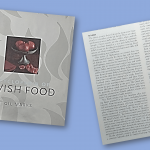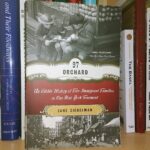Yom HaShoah, Israel’s official Holocaust Remembrance Day, has just begun this evening. And so, I wanted to take a few minutes to write a post that relates to the day, as well as to Jewish Food History.
Many of you may be wondering what there could possibly be to write about on this topic, and indeed it is largely a post about what was lost. But slightly more accurately, this is a post about what almost was lost, and the efforts that are being made to combat that loss.
The Damage
We all know about the millions of Jews who the Nazis murdered during the Holocaust, a personal blow to the even more millions whose families were torn apart and a national blow to the Jewish nation overall. Though the Jewish population of the world has grown strongly over the decades, it has still not reached to pre-Holocaust numbers. If those six million had not been ripped from our people, think how many Jews would be living in the world today, generations later. The concept is staggering.
But in addition to the familial and demographic damage, the Nazis also decimated giant segments of Jewish culture. Synagogues, ritual objects, libraries and archives — so much destroyed in just a few years. Compound that with the generation of creators — authors, thinkers and artists — who were also wiped out, and we see the persisting effects of Hitler’s actions and plans.
Within the cultural realm, perhaps no segment was hit harder than that of Jewish cuisine. As a folk art, of sorts, the bulk of our culinary knowledge is not to be found in books. The great repository of this information is in the collective consciousness of our people, perpetuated by millions of mothers teaching their millions of daughters by word of mouth. But when such a large percentage of that knowledge base is killed before they have the opportunity to transmit what they know, the chain of oral culture is broken, and the knowledge can be lost.
Trying to research the Jewish foods of Europe prior to World War II is particularly challenging for this reason. Thankfully, however, it is not entirely impossible, and there are a number of projects that have contributed to preserving the remnants of this knowledge.
The Sources
A small number of Jewish cookbooks were published in Europe over the century that preceded the Holocaust. These, of course, form a core knowledge base to build around. But alone they are inadequate and highly limited.
Personal recipe collections are somewhat better. It was not uncommon for women to take cooking lessons and create a handwritten cookbook for their own personal use. Others might have wooden or metal boxes containing a gathered recipe collection. Though many of these were destroyed or lost during the war, many others survived, particularly via those who escaped Europe before the war, or who survived the Holocaust itself.
Finally, those same survivors and pre-war escapees, are a primary source of knowledge in themselves. Though most are obviously rather elderly at this point, many are still able to be interviewed to discuss their food memories. And many others have been interviewed previously, with the recordings of those interviews sitting in archives.
Via these sources, a number of people have created projects that are today directly combatting this aspect of the damage that the Nazis perpetrated.
The Projects
A few well-researched books draw on all of these types of sources to recreate as much knowledge of specific regional Ashkenazi cuisines as possible. I’d like to highlight two in particular. The mother-daughter team of Gabrielle Rossmer Gropman and Sonya Gropman collaborated on 2017’s The German-Jewish Cookbook. Gabrielle was born in Germany and her parents brought her as a baby when they fled to the U.S. in 1939. They settled in Washington Heights, NY, where the greatest concentration of German Jews could be found. She and her adult daughter created this well-researched book that intersperses classic German-Jewish recipes with personal stories and history, both of their family and of the people who they interviewed. They created a comprehensive documentation of the cuisine that was almost lost, the motivating factor for their project.
Even more comprehensive, and more a social history with recipes than a cookbook with essays, is Jewish Cuisine in Hungary by András Koerner. A winner of the 2019 National Jewish Book Award, the book explores nearly every aspect that connected to the food habits of the Jews of Hungary before World War II, from kashrut observance (or the lack thereof), to regional and class variations, to food businesses, and more. And in addition to the in-depth writing he presents, the book also includes 83 recipes for classic dishes. This is the second book the Koerner wrote on the subject, with A Taste of the Past his previous effort which focused almost exclusively on the culinary world of his own great-grandmother.
A few other books are less focused on the research, and more on personal stories. Alex Sternberg wrote Recipes from Auschwitz to tell the specific life story of his Hungarian-born parents, both Holocaust survivors. Interspersed throughout the book are various recipes and food-related stories that come from his “Anyu” (mother), Olga. One story he retells focuses on how she and the other women at Auschwitz would cook with their mouths and minds. Gripped by starvation-level hunger, these women did not avoid the thought of food. On the contrary, they embraced it, drawing on their memories to tell how they prepared certain dishes, affirming life by keeping these memories alive.
This type of “cooking” was not unique to Olga and her fellow inmates. We know of similar activities by many other people in other camps. Perhaps the most harrowing account may be found in Cara De Silva’s In Memory’s Kitchen. In the “model ghetto”/concentration camp of Theresienstadt, the women transcribed their remembered recipes into a handmade cookbook. Though the women who wrote it did not survive the Holocaust, the cookbook did, eventually making its way to the compiler’s daughter a quarter-century after the war! Eventually it was translated and published as this book.
A broader swath of survivors have their recipes and personal stories collected and published in two books compiled by Joanne Caras, the Holocaust Survivor Cookbook and its sequel Miracles and Meals. In these two books, proceeds of which go to a Jerusalem-based soup kitchen that is just a few blocks from my home, recipes come from Jews who originated in many different areas throughout Europe.
Perhaps the most inspirational project, however, is currently ongoing. Only recently there were a few articles out that highlighted the efforts of James Beard Award-winning chef Alon Shaya. After examining a family cookbook that had been donated to the U.S. Holocaust Memorial Museum in Washington, D.C. by survivor Steven Fenves, Shaya learned that Fenves actually volunteers as a guide at the museum. Collaborating with Fenves, Shaya explored his memories of some of his favorite dishes from the recipe collection, and recreated the dishes to match the memories. This helped Fenves to taste dishes again that he had not had in 75 years! The museum is currently trying to raise money in order to get more of the recipes translated, so Shaya can continue to keep this piece of our history alive.
In a very small way, these projects collectively preserve and/or reconstruct a part of that cultural repository that the Nazis sought to destroy. Hitler (may his name be erased) tried to wipe us from the planet. But despite the tremendous damage he caused, we survived as a people, and we are still here. cooking some of the foods that you can find in one of these many sources can be a great way to celebrate that triumph while also honoring the memories of those who were lost.







Emily Sacharin
I didn’t know about the Alon Shaya project – what a great story! I hope he ends up doing a book or something; would love to try some of the recipes.
On the subject of survivor cookbooks, are you familiar with Just Add Love? It’s a cookbook (and website) with recipes and stories from mostly Australian survivors. I think you’d enjoy checking it out, if you haven’t.
FunJoel
Hey Emily! Thanks for that. I was not familiar with the project. Will check it out. 🙂
2022: The Year in Jewish Food - Taste of Jewish Culture
[…] in the year. And at the very end of the year, we lost Cara De Silva who edited the remarkable book In Memory’s Kitchen, that included recipes recited from memory by Jewish women in Terezinstadt, who would later be […]